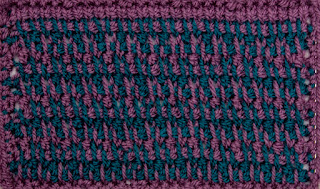Now that we are nearing the end of the Tunisian Patchwork CAL, I thought you may like to know where the name Tunisian Crochet came from.
Historical Background of Tunisian Crochet
|
|
Tunisian crochet first gained recognition in Western Europe during the early to mid-19th century—particularly in Britain and France—but its exact origins are not definitively known. Like many textile arts, it's evolved from a mix of influences over centuries, and names often reflect cultural perceptions more than geographic accuracy.
It is well known that Queen Victoria enjoyed the craft and it was called “Royal Princess Knitting” in her honour.
We started seeing references to techniques resembling Tunisian crochet in women's magazines and needlework books in the 1830s–1840s.
|
It wasn’t always called "Tunisian" crochet though—other names included: Tricot crochet, Afghan stitch, Railroad knitting and Shepherd's knitting.
The name “Tunisian crochet” likely emerged in the Victorian era, a time when exotic-sounding names were popular in marketing. Calling something "Tunisian" lent it an air of mystery and elegance, even if it had no real connection to Tunisia.
While there’s no solid evidence that the technique itself originated in Tunisia or North Africa, it’s possible that the visual texture of the fabric, which looks somewhat like weaving or traditional North African textiles, inspired the name.
Tunisian crochet has some similarities to: Nalbinding (an ancient Scandinavian technique), Knitting on hooked needles (seen in parts of the Middle East and Asia) and crochet-like stitches in Egyptian and North African textiles, though these are not directly linked.
So in essence, the "Tunisian" in Tunisian crochet is more Victorian branding than actual geography.
What is Tricot Crochet?
The term “tricot” comes from the French word for knitting, which hints at how this style of crochet was perceived in the 19th century—it was seen as a hybrid between knitting and crochet.
In early Victorian needlework books, tricot crochet referred to a technique where the stitch was picked up like knitting (holding loops on the hook), then worked off in a second pass—very much like modern Tunisian simple stitch (Tss).
It wasn’t limited to one stitch, but the simple stitch—what today we call the "Tunisian Simple Stitch"—was the foundation.
Evolution of the Name
In the Mid-1800s, “Tricot” crochet began appearing in instruction manuals alongside knitting and traditional crochet. It was seen as a newfangled alternative—faster than knitting, sturdier than regular crochet.
Eventually, the technique began to take on regional and stylish names: “Tunisian crochet” (sounding exotic), “Afghan stitch” (popular in the US, especially in blanket-making) and “Shepherd’s knitting” (a more rustic, practical name).
|
Some books even used these names interchangeably, which makes the historical tracing a bit confusing.
Victorian manuals like The Lady’s Manual of Fancy-Work (circa 1850s) included tricot crochet instructions, often accompanied by patterns for warm garments and household items like mittens, baby jackets, coverlets and blankets.
The emphasis was on efficiency and texture—tricot crochet made dense, warm, and somewhat elastic fabrics, ideal for the drafty homes of the time.
|
|
Tricot crochet became popular because:
It mimicked knitting without needing two needles.
It was easier to learn for those who already knew crochet.
The resulting fabric had a woven look and didn’t curl as much as knitted stockinette.
And because it could be done with just one long hook, it was more portable—a huge bonus for women who travelled or worked in shared spaces.
Tricot Crochet vs. Tunisian Crochet?
They are, functionally, the same thing. The terminology just shifted over time. “Tricot” crochet was the earlier, European term while “Tunisian” crochet became the more widespread, modern label—especially in the English-speaking world.































